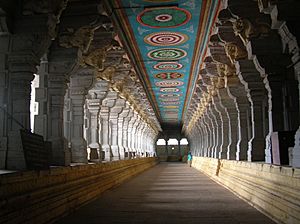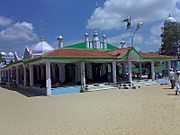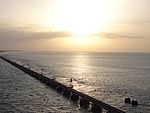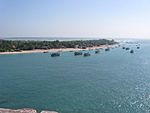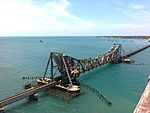Ramanathapuram district facts for kids
Quick facts for kids
Ramanathapuram district
Ramnad District
|
|
|---|---|
|
District
|
|
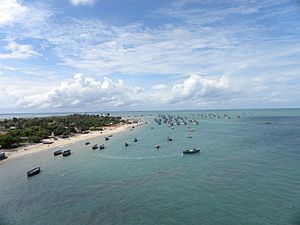
Aerial view of the Rameswaram island from Pamban Bridge
|
|
| Nickname(s):
Mugavai Mavattam
|
|
| Country | |
| State | Tamil Nadu |
| Municipalities | Ramanathapuram Paramakudi Rameswaram Kilakarai |
| 'Largest City By Population' | Paramakudi |
| 'Largest City by Area' | 'Ramanathapuram' |
| Headquarters | Ramanathapuram |
| Talukas | Kadaladi Kamuthi Kilakarai Mudukulathur Paramakudi RajaSingaMangalam - R.S.Mangalam Ramanathapuram Rameswaram Tiruvadanai |
| Population
(2011)
|
|
| • Total | 1,353,445 |
| Languages | |
| • Official | Tamil |
| Time zone | UTC+5:30 (IST) |
| PIN |
623xxx
|
| Telephone code | 04567 |
| Vehicle registration | TN-65 |
| Central location: | 9°16′N 77°26′E / 9.267°N 77.433°E |
Ramanathapuram District is an administrative district of Tamil Nadu state in southern India. The town of Ramanathapuram is the district headquarters. Ramanthapuram District has an area of 4123 km2. It is bounded on the north by Sivaganga District, on the northeast by Pudukkottai District, on the east by the Palk Strait, on the south by the Gulf of Mannar, on the west by Thoothukudi District, and on the northwest by Virudhunagar District. The district contains the Pamban Bridge, an east-west chain of low islands and shallow reefs that extend between India and the island nation of Sri Lanka, and separate the Palk Strait from the Gulf of Mannar. The Palk Strait is navigable only by shallow-draft vessels. It also contains Theriruveli, a small village. As of 2011, Ramanathapuram district had a population of 1,353,445 with a sex-ratio of 983 females for every 1,000 males.
Demographics
| Historical population | ||
|---|---|---|
| Year | Pop. | ±% p.a. |
| 1901 | 442,067 | — |
| 1911 | 477,726 | +0.78% |
| 1921 | 479,202 | +0.03% |
| 1931 | 517,471 | +0.77% |
| 1941 | 577,826 | +1.11% |
| 1951 | 551,125 | −0.47% |
| 1961 | 702,168 | +2.45% |
| 1971 | 822,623 | +1.60% |
| 1981 | 998,295 | +1.95% |
| 1991 | 1,119,153 | +1.15% |
| 2001 | 1,187,604 | +0.60% |
| 2011 | 1,353,445 | +1.32% |
| source: | ||
According to 2011 census, Ramanathapuram district had a population of 1,353,445 with a sex-ratio of 983 females for every 1,000 males, much above the national average of 929. A total of 140,644 were under the age of six, constituting 71,705 males and 68,939 females. Scheduled Castes and Scheduled Tribes accounted for 18.4% and .08% of the population respectively. The average literacy of the district was 72.33%, compared to the national average of 72.99%. The district had a total of 323,905 households. There were a total of 602,977 workers, comprising 149,959 cultivators, 103,592 main agricultural labourers, 18,546 in house hold industries, 214,053 other workers, 116,827 marginal workers, 23,808 marginal cultivators, 50,282 marginal agricultural labourers, 6,682 marginal workers in household industries and 36,055 other marginal workers.
History
In the early 15th century, the present territories of Ramanathapuram district, comprising taluks Tiruvadanai, RajaSingaMangalam, Paramakudi,Ramanathapuram and Rameswaram, Kamuthi, Mudukulathur in Pandyan Dynasty. For a short period, this area was under the Kings when Rajendra Chola I brought it under his territory in 1063 AD. In 1520 AD, the Nayaks of Vijayangar took over the area under their control from the Pandiyan dynasty for about two centuries, Marava chieftains-Sethupathis who were Lords under Pandiyan Kings and reigned over this part (17th century). At the beginning of the 18th century, family disputes over succession resulted in the division of Ramanathapuram. With the help of the King of Thanjavur in 1730 AD, one of the chieftains deposed Sethupathy and became the Raja of Sivaganga. Acting upon the weakness of the Nayak rules, the local chieftains (Palayakarars) became independent. Raja of Sivagangai and Sethupathy of Ramanathapuram were prominent among them. In 1730, Chand, a Sahib of Carnatic, captured Ramanathapuram. In 1741, the area came under the control of the Marattas and then under the Nizam in 1744 AD, Nawab’s rule made displeasure in the mind of those chieftains. That made them declare the last Nayak as ruler of Pandiya Mandalam against the Nawab in 1752 AD. By that time, throne of Carnatic had two rivals, Shanda Sahib and Mohamed Ali, and this district was part of Carnatic. The British and French supported Chanda Sahib and Mohamed Ali respectively. It paved the way for series of conflicts in the southern part of the continent.
In 1795, the British deposed Muthuramalinga Sethupathy and took control of the administration of Ramanathapuram. In 1801 Mangaleswari Nachiyar was made the Zamindar of Sivagangai. After passing of Queen, the Marudhu Brothers took the charge by paying regular revenue to the East India company. In 1803 the Marudhu Brothers of Sivaganga revolted against the British in collaboration with Kattabomman of Panchalamkurichi. Colonel Agnew captured Marudhu Brothers and hanged them and made Gowri Vallbah Periya Udaya Thevar as Zamindar of Sivaganga. After the fall of Tippu Sultan, British took the control and imprisoned the Nawab. In 1892, the Zamindari system was abolished and a British Collector was appointed for administration.
In 1910, Ramanathapuram was formed by clubbing portions from Madurai and Tirunelveli district. Shri J.F. Bryant I.C.S was the first collector. And this district was named as Ramanathapuram. During the British period this district was called “Ramnad”. The name continued after independence. Later the district was renamed as Ramanathapuram to be in conformity with the Tamil name for this region.
Geology
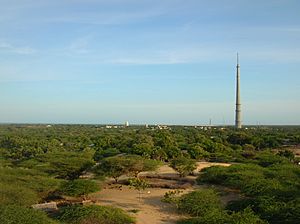
Most of the area is covered by the unconsolidated sediments of Quaternary age except in the northwestern part, where isolated patches of Archaen Crystallines and Tertiary sandstone are exposed. The Archaeans are mainly represented by the Charnockite Group of rocks comprising garnetiferrous granulite and the Khondalite Group of rocks made up of quartzite of genesses.
The Tertiary sandstone (Cuddalore Formation) comprise pinkish, yellowish, reddish (variegated colours) medium to coarse grained sandstone and clay stone. It is overlain by thin alluvium and exposed towards north of Vaigai River.
Detached exposures of laterite and lateritic soil are seen in the northwestern part of the district.
A major part of the district is covered with the fluvial, fuvio-marine, Aeolian and marine sediments of Quaternary age. The fluvial deposits which are made up of sand, silt and clay in varying degree of admixture occur along the active channels of Vaigai, Gundar, Manimuthar and Pambar rivers. They have been categorised into levee, flood basin, channel bar/ point bar and paleo-channel deposits. The paleo channel deposits comprise brown coloured, fine to medium sands with well preserved cross-beddings.
The fluvio-marine deposits are exposed in the Vaigai delta as deltaic plain, paleo-tidal and dune flat deposits. The deltaic plain and dune flats comprise medium, grey brown sands. The paleo tidal flat deposits include black silty clay, black clay and mud. In Rameswaram Island, the fluvio-marine deposits include indurated sand and dune sands.
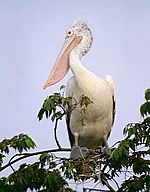
The Aeolian deposits comprise red sands which are in nature of ancient dunes and occur over a 3.2 km wide and 8 km long stretch and lie parallel to the sea coast. These are separated by marshy deposits of black clays. The sands are underlain by calcareous hardpan. In Rameswaram Island also brown sand deposits occur around Sambaimadam on either side of NH 49 west of the town.
The marine formation comprises coastal plain deposits of sand and clay in varied proportion. Marine calcareous hardpan occurs as low terraces and platforms, with admixture of quartz, limonite and garnet concentration.
Tourist attractions
- Ramanathapuram (Palace - This palace was built during the reign of Kizhavan Sethupathi (1674-1710 CE) the most popular among the Sethupathi kings.)
- Rameswaram (sangumaan beach)
- Thangachimadam Grave of Dr A.P.J. Abdul Kalam, near Peikarumbu
- Dhanushkodi
- Pamban Bridge (Annai Indira Gandhi Bridge)
- Kundhukal - Vivekananda Memorial
- R S madai (Sea World Aquarium)
- Naagachi (Naagachi Amman Temple)
- Kamuthi(Pasumpon Dever Memorial)
- Kanjirankulam Bird Sanctuary
- Chitrangudi Bird Sanctuary
- Alagankulam Bird Sanctuary
- Melselvanur-Keelselvanur Bird Sanctuary
See also
 In Spanish: Distrito de Ramanathapuram para niños
In Spanish: Distrito de Ramanathapuram para niños


